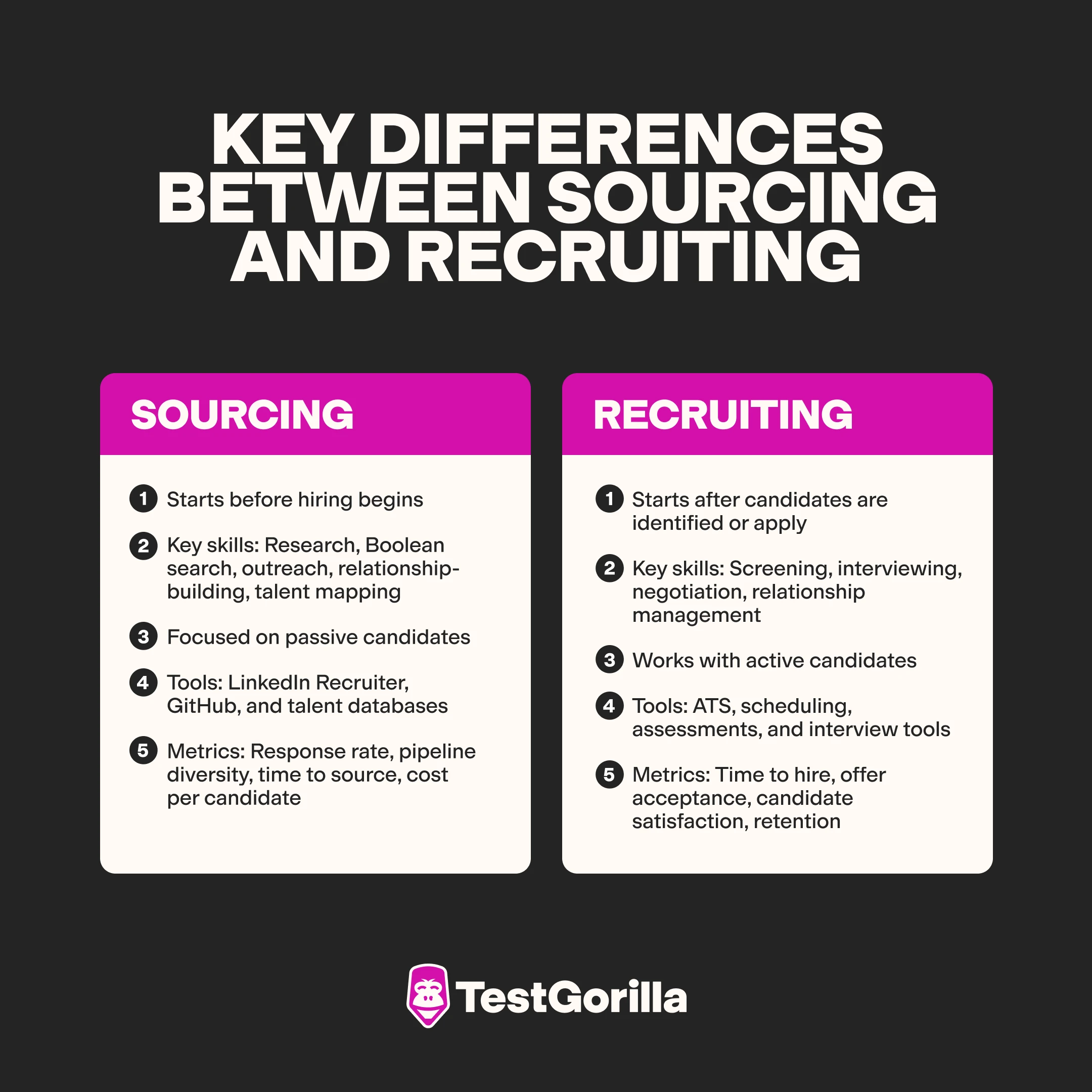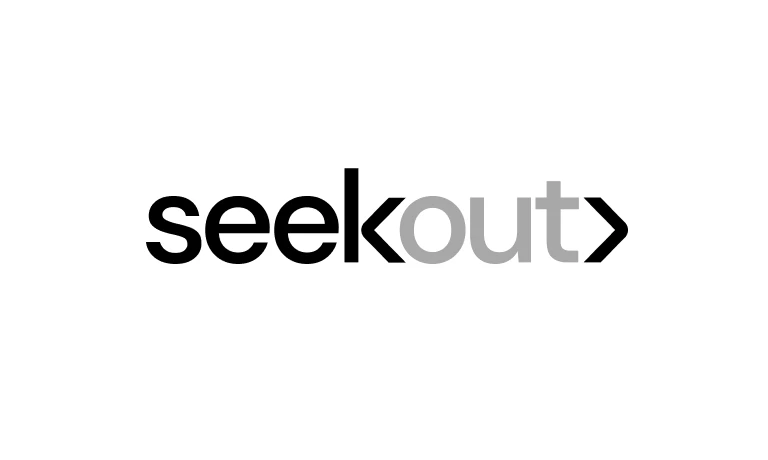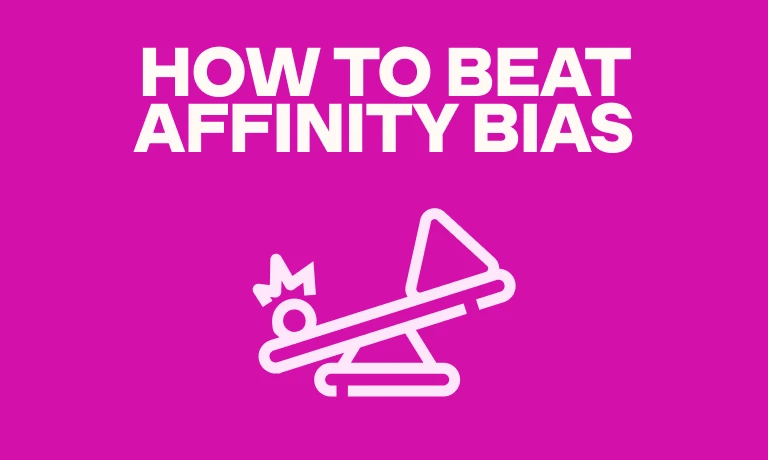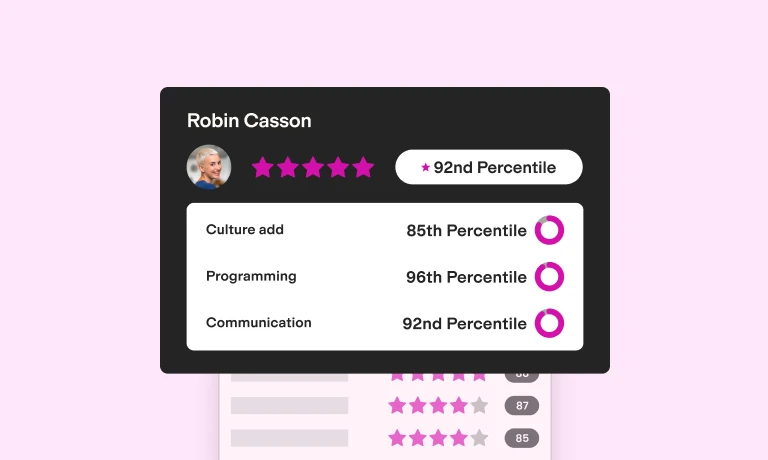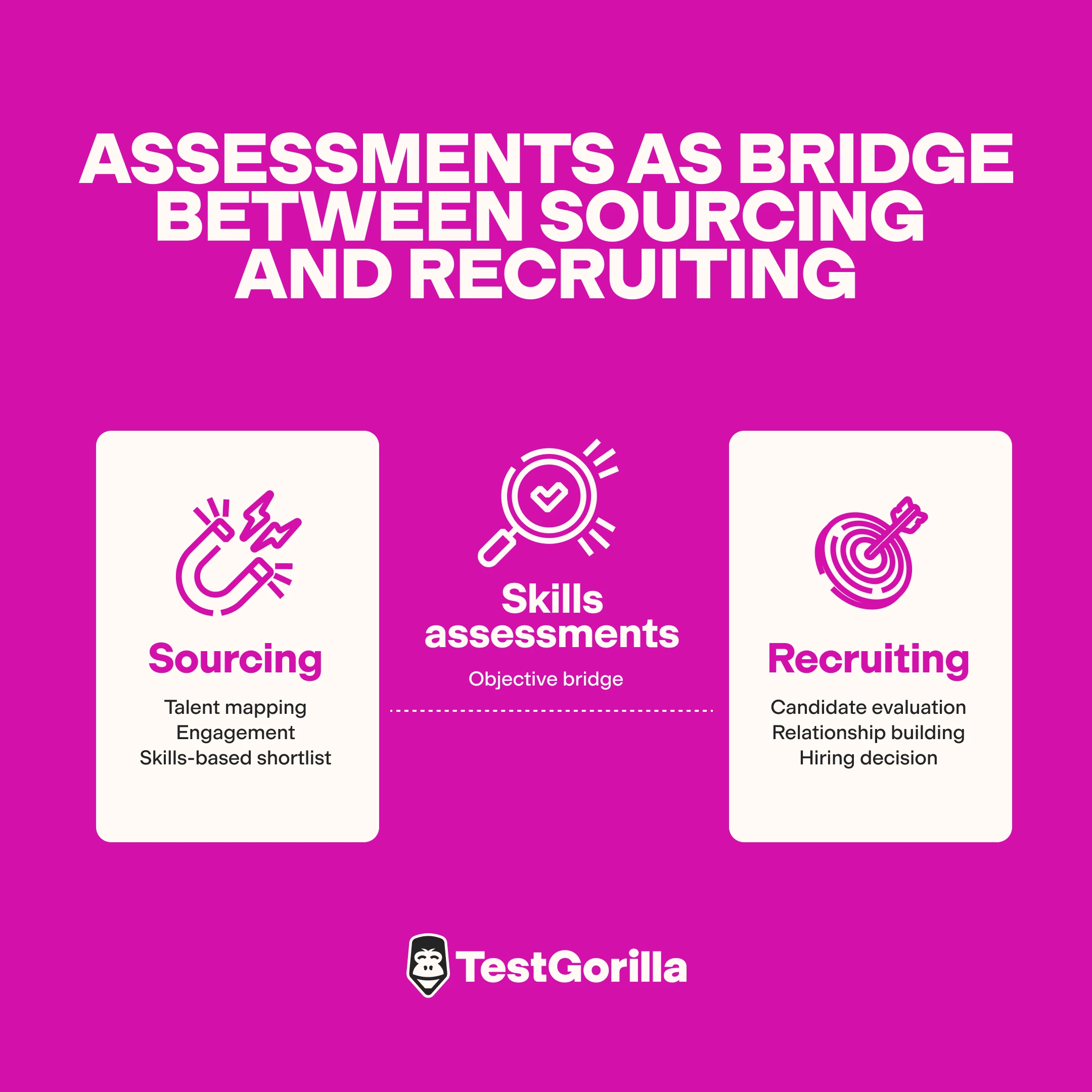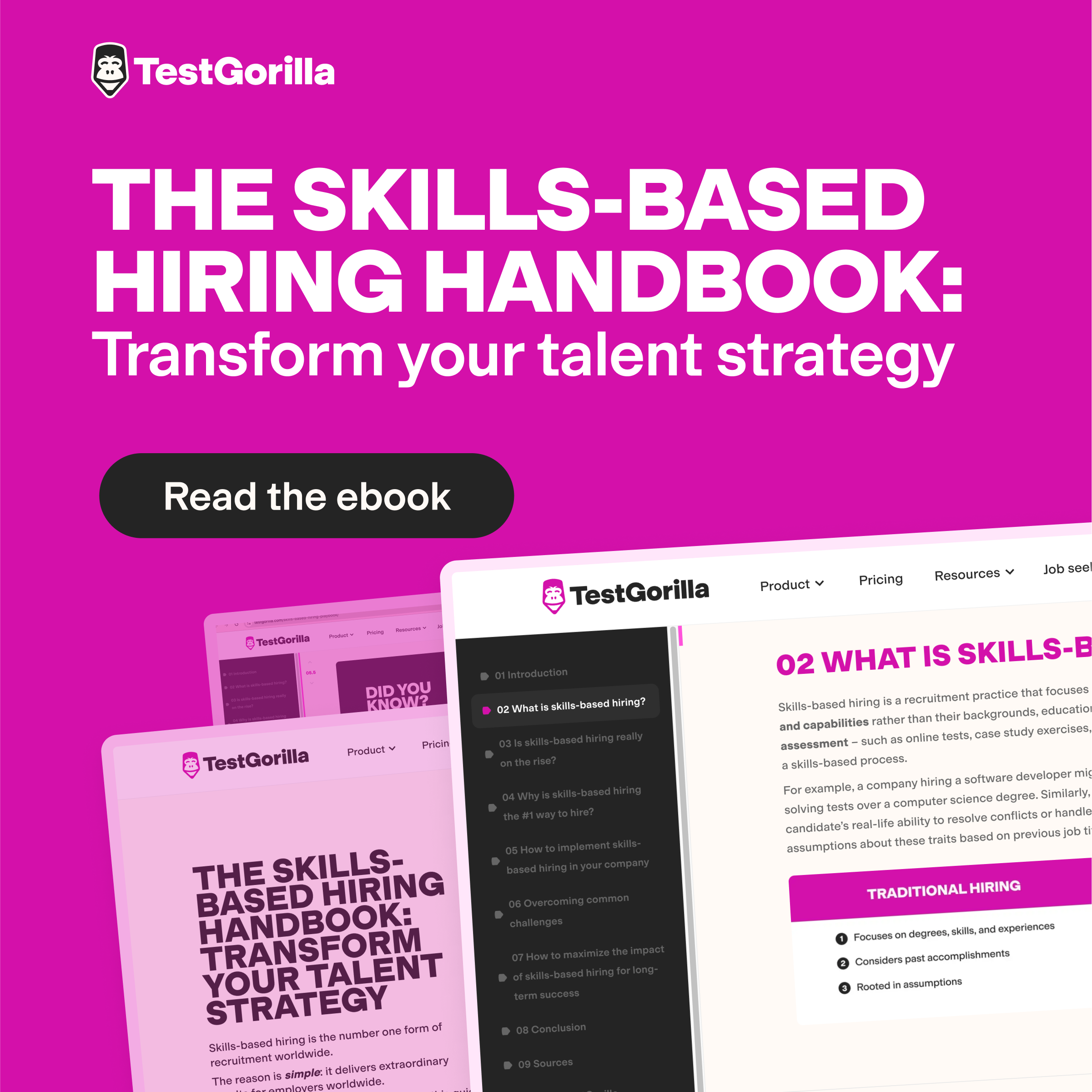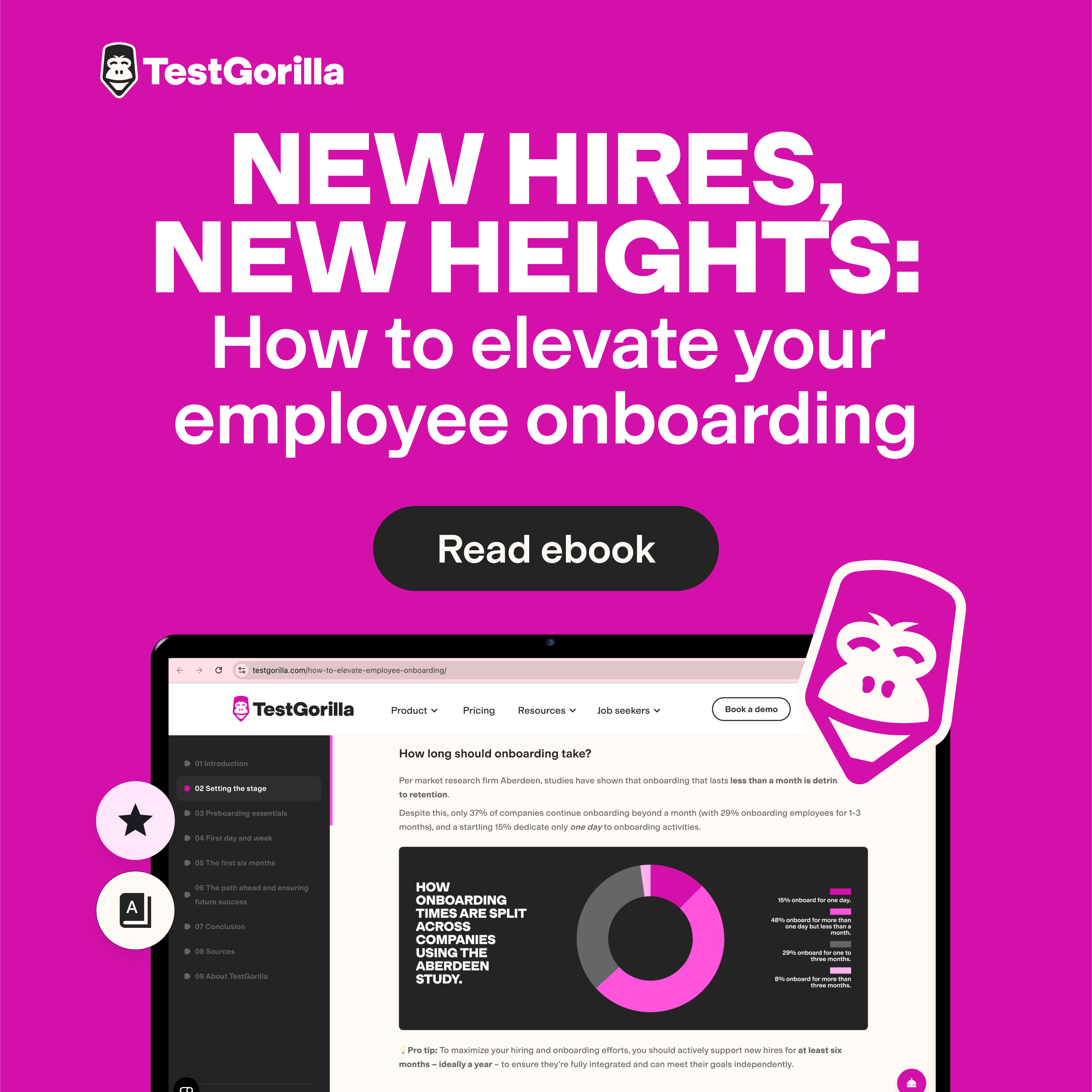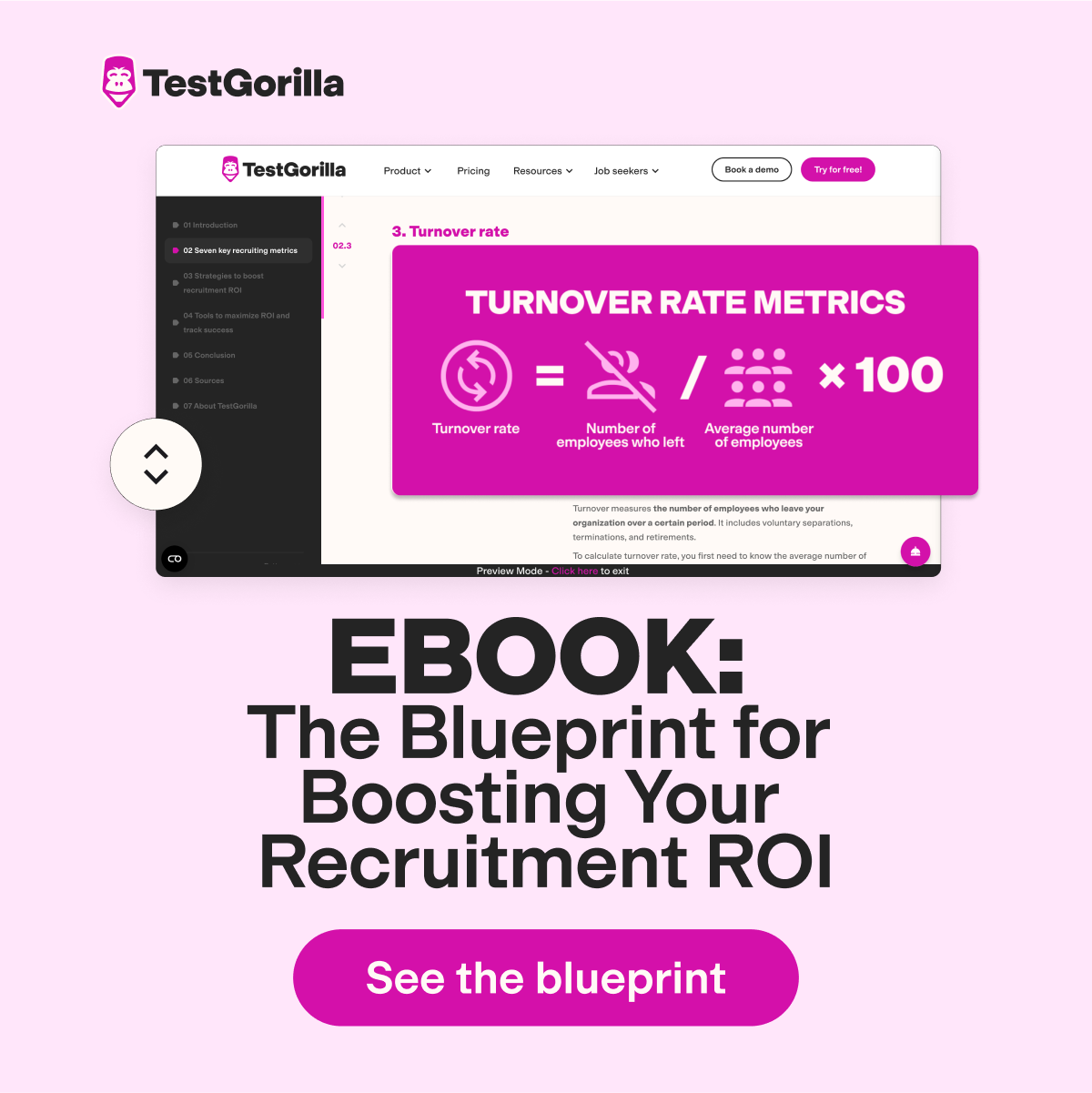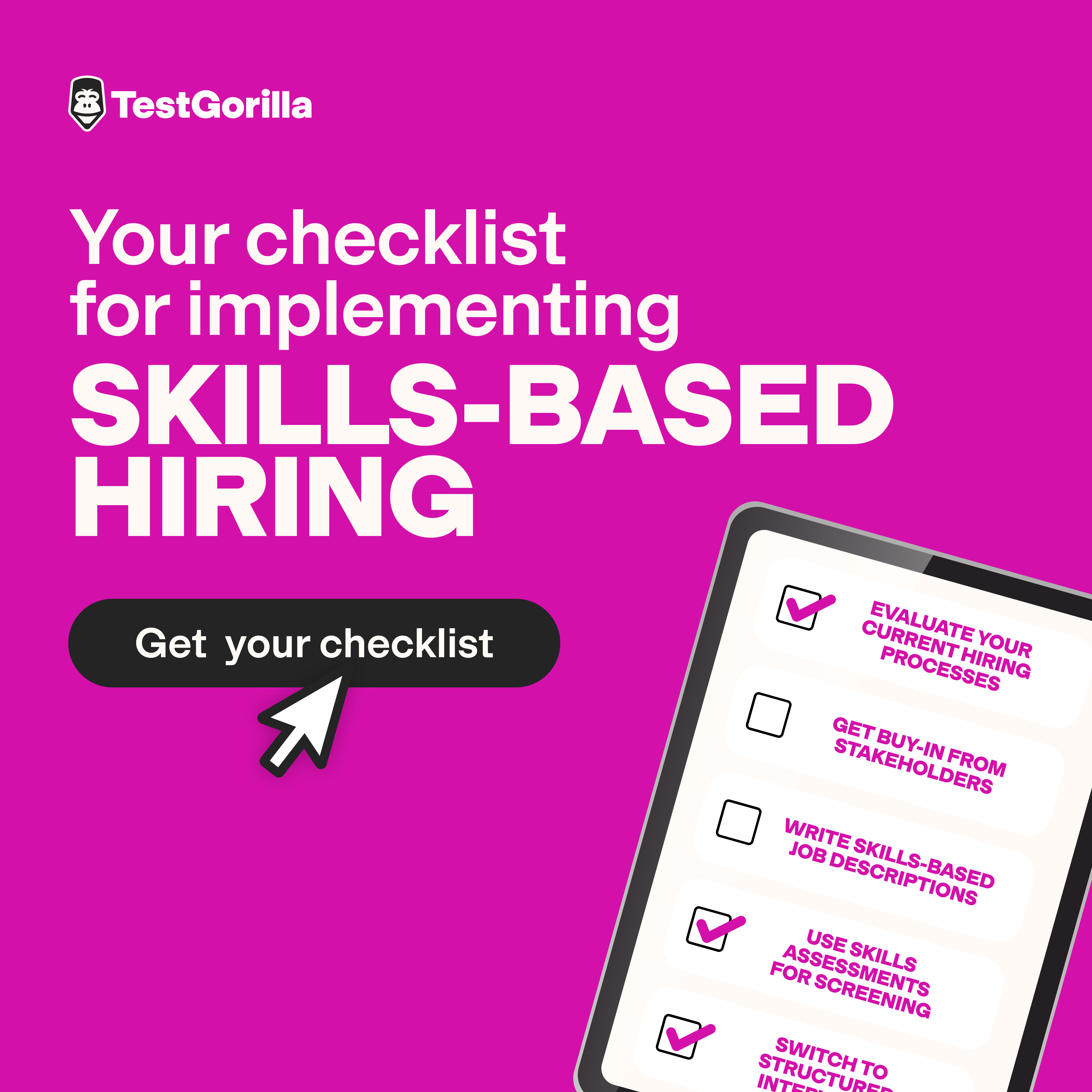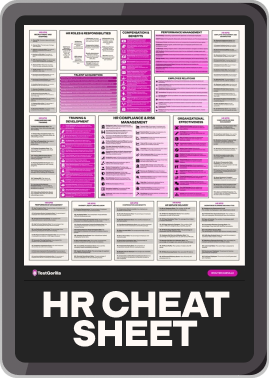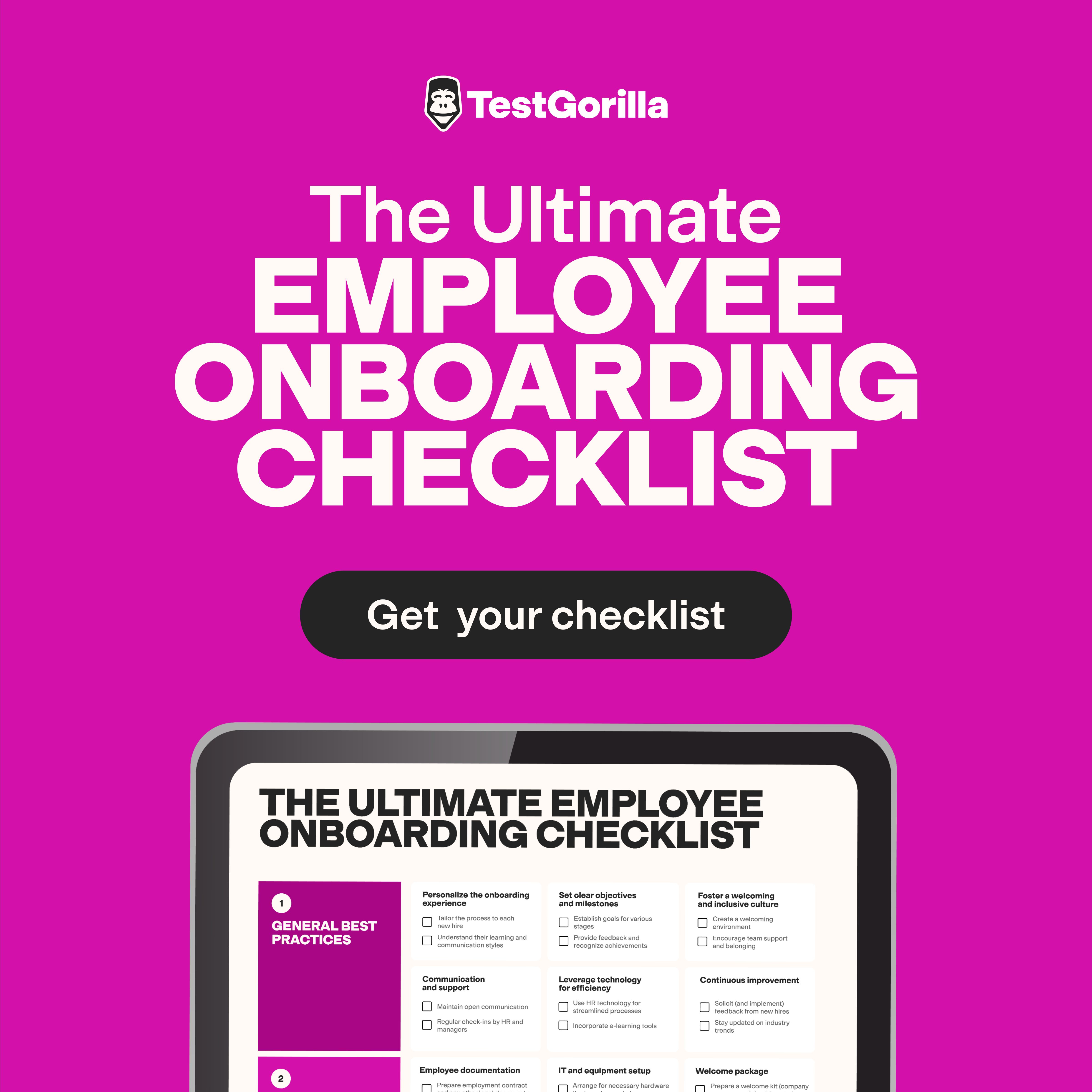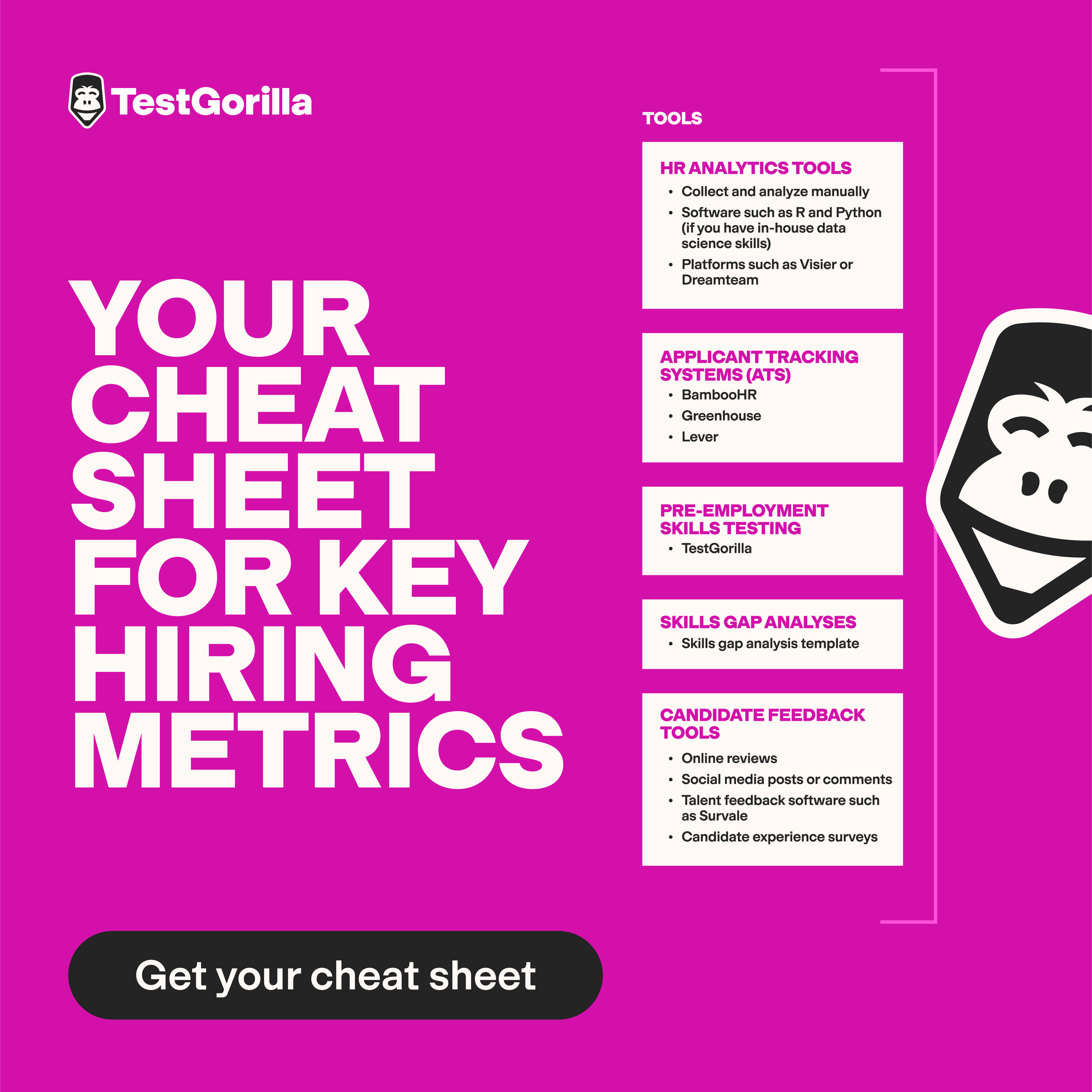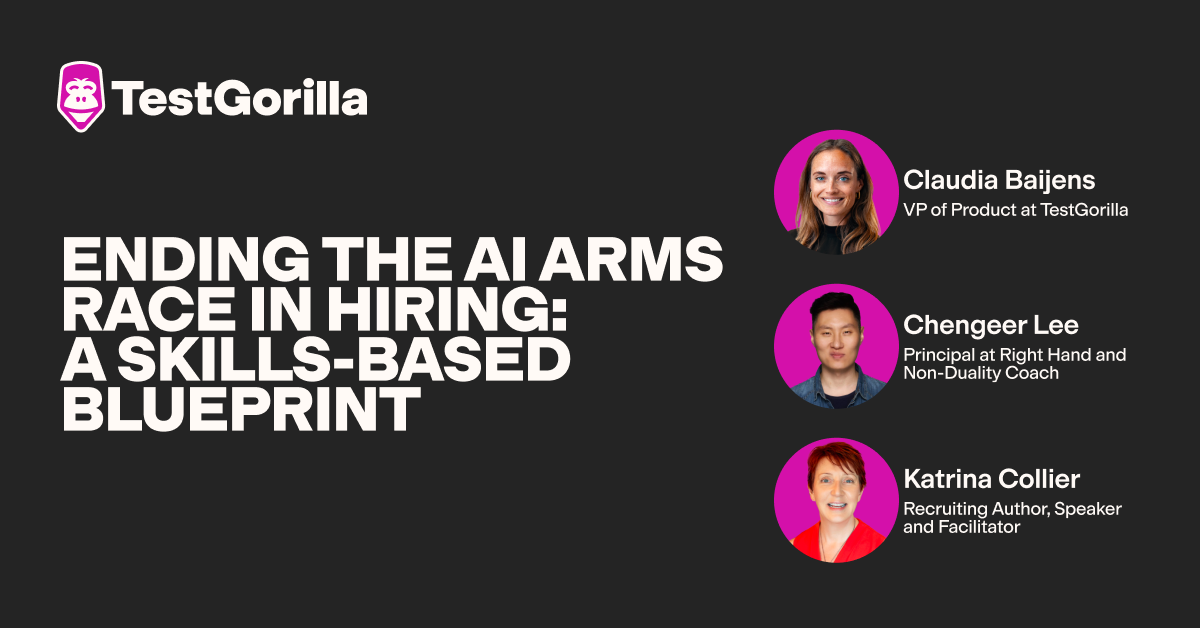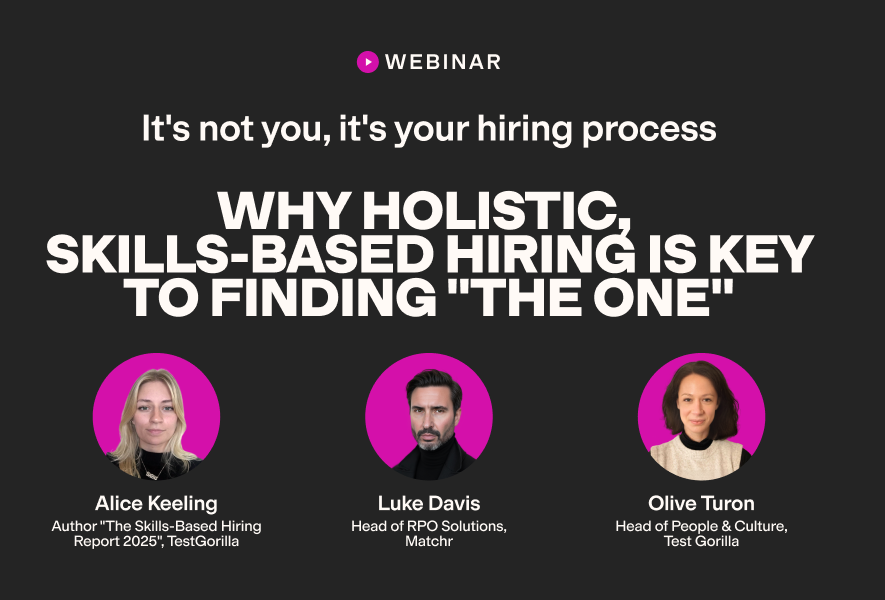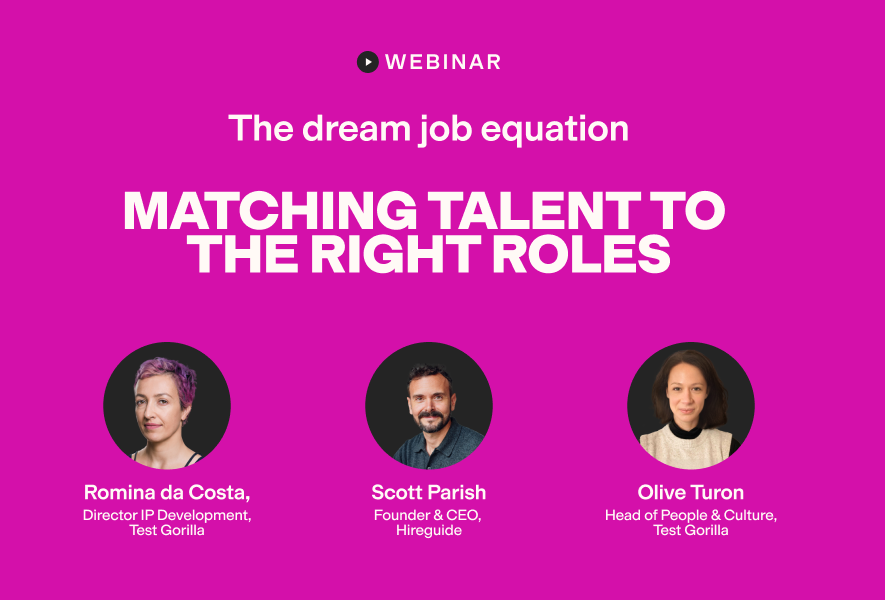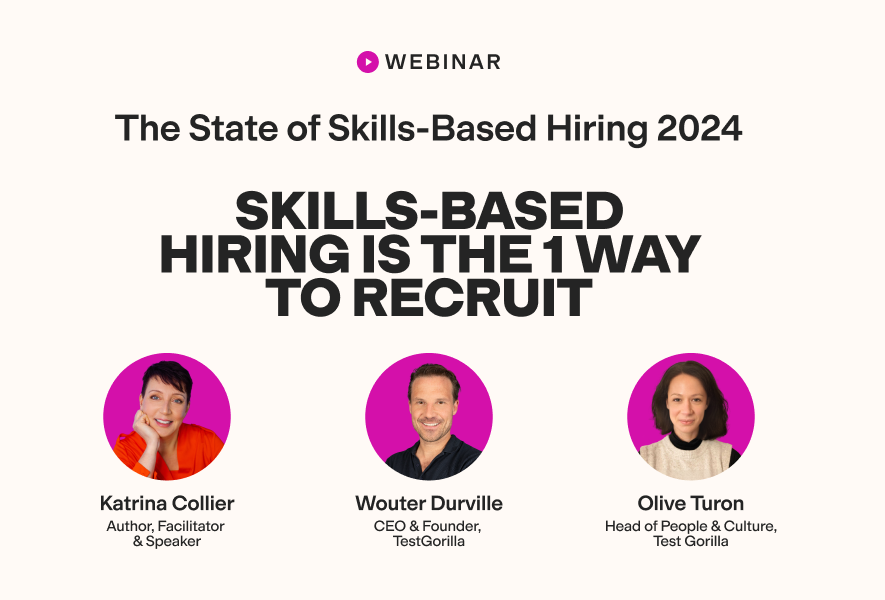Ask five recruiters what “sourcing” means, and you’ll get five different answers. Some view it as the start of recruiting, others consider it a separate discipline, and many use the terms interchangeably.
That lack of clarity doesn’t just cause confusion. When teams aren’t aligned on who’s responsible for what, hiring slows down, responsibilities get blurred, and the candidate experience suffers.
Below, we break down the key differences between sourcing and recruiting, how the two fit together, and where technology changes the picture. We’ll also show you how a skills-first approach with TestGorilla Sourcing can help you turn those differences into a stronger, more reliable hiring process.
What is sourcing?
Sourcing is the proactive search for potential candidates, often before they apply and sometimes even before a role is open.
The goal of sourcing is to identify and engage individuals who could be a good fit, build relationships with them, and keep them in a pipeline for both current and future hiring needs.
“Think of it like a funnel,” Karishma Veljee, Founder of DigitalHire, tells us. “The more you put at the top [in sourcing], the better your chances of filling the position with the right person.”
In most cases, “sourcing,” “talent sourcing,” and “candidate sourcing” refer to the same thing: the proactive search for potential candidates. Some teams, however, use “candidate sourcing” to refer specifically to the day-to-day, hands-on work of identifying and engaging candidates. |
What are sourcers responsible for?
Researching and identifying candidates across professional networks, social platforms, online communities, talent databases, and industry events
Building and maintaining a pipeline of talent for current and future roles
Reaching out to passive candidates and starting conversations
Screening at a high level to make sure candidates align with role requirements
Tracking outreach metrics like response rates and pipeline diversity
What is recruiting?
Recruiting is the process of guiding identified candidates through the hiring journey – from first conversations to signed offer and onboarding. Jim Stroud, an HR influencer, explains it as such:
“Recruiting picks up where sourcing leaves off. It’s full-cycle: the pitch, the evaluation, the hand-holding, the negotiations, the close. Recruiters live in the trenches with hiring managers, managing expectations and smoothing out the rollercoaster from first ‘hello’ to signed offer."
Compared to sourcing, recruiting is less about search and more about evaluation, communication, and decision-making.
What are recruiters responsible for?
Screening candidates with assessments, interviews, and reference checks
Coordinating feedback with hiring managers and interview panels
Managing communication and expectations for both sides
Negotiating offers and guiding candidates through acceptance
Supporting onboarding and candidate experience at the final stage
The best insights on HR and recruitment, delivered to your inbox.
Biweekly updates. No spam. Unsubscribe any time.
Key differences between sourcing and recruiting
Although sourcing and recruiting are closely connected, they serve distinct roles in the hiring process. Sanja Sreckovic, Head of Recruitment at DesignRush, shares a simple analogy to highlight the two functions’ differences:
“I like to compare sourcing and recruiting to fishing. Sourcing is casting the net. You go out into the ocean of talent, spot where the best fish might be, and bring them closer.
“Recruiting starts once you have brought the fish to shore. It is about choosing the right ones, preparing them, and making sure they are the right fit for the table, in this case the company.”
With that picture in mind, let’s take a closer look at how sourcing and recruiting differ across the key stages of hiring.
Aspect | Sourcing | Recruiting |
Timing | Begins before or at the start of a hiring need | Starts once candidates are identified or apply |
Focus | Discovering, engaging, and nurturing potential candidates | Evaluating, selecting, and closing candidates |
Core skills | Research, Boolean searches, outreach, relationship-building, talent mapping | Screening, interviewing, negotiation, relationship management |
Candidate type | More focused on passive talent, but also builds pools for future roles | Mix of sourced and active applicants |
Tools | Sourcing tools such as LinkedIn Recruiter, GitHub, talent databases, mapping platforms | ATS, scheduling tools, assessments, interview platforms |
Metrics | Response rate, pipeline diversity, time to source, cost per candidate | Time to hire, offer acceptance, candidate satisfaction, retention |
Timeline
Sourcing usually happens earlier in the overall hiring process than recruiting. Sourcers build lists of potential candidates, engage with them, and warm up the pipeline so there’s already interest when a role opens.
Recruiting then begins once candidates have been identified, either through sourcing or direct applications.
Passive vs. active candidates
Sourcing is more focused on passive candidates than recruiting is. Sourcers often identify passive talent – professionals who aren’t actively applying but might be open to the right role – through social media, referrals, or online profiles and portfolio contributions on platforms like LinkedIn or GitHub.
Recruiting tends to work more with active candidates – people who have applied, responded to outreach, or otherwise entered the hiring funnel. Recruiters then screen, evaluate, and manage their progress.
Responsibilities
Sourcers act as scouts. They research candidates, qualify them at a high level, and hand over a strong pipeline.
Recruiters manage the later stages of the hiring process. They handle tasks like posting jobs, scheduling, coordinating assessments, conducting interviews, and preparing offers.
Candidate interactions
Sourcers typically make the first point of contact, which may be a LinkedIn message, an email that sparks interest, or sometimes a short call.
Once the candidate shows willingness, recruiters step in for deeper engagement. They answer detailed questions, organize interviews, and maintain contact with the candidate throughout the negotiation and onboarding process.
Collaboration with hiring managers
Sourcers often connect with hiring managers early to clarify role requirements – which skills are essential, which qualifications are flexible, and where to focus searches. This ensures the pipeline is aligned with real needs from the start.
Recruiters then take the lead as the process progresses. They serve as the primary liaison between hiring managers and candidates, coordinating interviews, sharing feedback, and helping guide final decisions.
Tools
Sourcers rely on a wide range of sourcing tools and search platforms, including LinkedIn Recruiter, sourcing databases such as SeekOut, talent mapping tools like HireEZ, and even applicant tracking systems (ATS) or job boards when looking to re-engage past applicants.
They also use Boolean strings – custom search queries that combine keywords, operators, and filters – to refine searches and uncover hidden talent.
The goal of all these tools is straightforward: to identify, engage, and nurture potential candidates before recruiters step in.
Recruiters use applicant tracking systems such as Greenhouse or Lever to manage candidate pipelines, scheduling tools like Calendly to coordinate interviews, and candidate evaluation platforms, including skills-based assessments from TestGorilla.
Together, these tools help recruiters efficiently move candidates through the hiring funnel, focusing on both fit and long-term potential.
Metrics
Sourcers and recruiters also focus on different metrics:
Sourcing metrics
Response rate: How many candidates reply to outreach
Pipeline diversity: Representation across skills, backgrounds, and demographics
Time to source: How long it takes to build a viable shortlist
Cost per sourced candidate: Efficiency of sourcing activities
Skills coverage: How well candidates map to the skills required for the role
Recruiting metrics
Time to hire: Speed from application or shortlist to signed offer
Offer acceptance rate: Percentage of candidates who accept offers
Candidate experience: Measured through surveys or feedback scores
Quality of hire: Post-hire performance or retention at 6–12 months
How sourcing feeds the recruiting pipeline
As we’ve seen, sourcing and recruiting are designed to work in sequence. When done well, sourcing delivers a shortlist of skilled, engaged candidates that recruiters can guide through the rest of the process.
Here’s how the flow usually looks:
The role and candidate profile are defined: Hiring managers, recruiters, and sourcers align on what skills are essential, what qualities are nice-to-have, and where flexibility exists.
Sourcing begins: Sourcers research across databases, platforms, and communities to find potential candidates. They make initial contact, check for fit, and build a pool of interested talent.
Recruiting takes over: With a verified shortlist, recruiters move candidates through structured evaluations, interviews, and fit assessments.
Feedback is shared: Recruiters share insights on candidate quality back to sourcers, who refine their searches based on what works best.
The future of sourcing and recruiting is skills-first
Sourcing and recruiting have always been connected, but more and more, hiring teams are rethinking how the two functions work together. The shift is toward a skills-first approach, where ability matters more than background.
Resumes and job titles – once the main signals of fit – rarely tell the whole story and often blur real differences instead of revealing them. As Veljee tells us, “We don’t want the recruiters to pre-judge candidates based on their resumes or profiles. Especially in today’s job market where everyone’s resume looks and sounds the same, thanks to AI-generated templates.”
That is why verifying skills early has become so important. In our report, Sourcing Success: The Secret Source, we found that 58% of teams struggle to confirm whether candidates actually possess the abilities they claim. Without that confidence, sourcers may hand recruiters a stack of names instead of a shortlist of people who can succeed.
AI adds another twist. On its own, it can make the noise louder by generating polished but untested profiles. Yet used differently, AI can help by scanning large volumes of data, surfacing hidden talent, and speeding up outreach. The trick is not to stop there. AI can open doors, but only skills-based assessments show who is truly ready to walk through them.
How TestGorilla brings skills-based sourcing and recruiting to life
This is where TestGorilla connects the two worlds.
With TestGorilla Sourcing, sourcers don’t have to guess at job fit based on profiles alone. They can send short, role-relevant assessments right in their outreach – so from the very first interaction, they know which candidates actually have the skills to succeed.
Recruiters then pick up the same skills data through TestGorilla Assessments. Instead of relying solely on resumes, recruiters evaluate candidates through assessments that measure job-specific skills, personality traits, behavioral characteristics, and more. Assessment results can be compared, with AI helping to score essays, videos, and custom responses – always guided by human oversight.
In other words, TestGorilla gives sourcers and recruiters real evidence to work from, creating a seamless handoff and leading to better-quality hires. That’s the future of sourcing and recruiting – and it’s here today, with 85% of employers using skills-based hiring.
Curious to know more? Get started today with a free TestGorilla plan, or book a 30-minute live demo with our team.
Contributors
Karishma Veljee – Founder, DigitalHire
Jim Stroud – HR & Talent Acquisition Influencer, Podcaster, Author
Sanja Sreckovic – Head of Recruitment, DesignRush
You've scrolled this far
Why not try TestGorilla for free, and see what happens when you put skills first.


